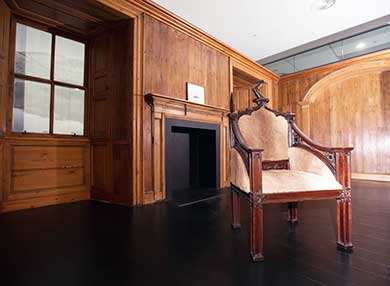Our sustainable modern Library
Waranara Library is centrally located on campus and is a learning and research environment purpose-built to facilitate interactions between people and knowledge.
Completed in 2011, the building takes its inspiration from the campus’ native parklands – emphasising environmental sustainability, natural light and connectivity characteristics.
Study facilities
Waranara Library is a modern study space that can seat up to 2200 people. We have dedicated areas set aside for group work, presentation practice, and for postgraduate and higher degree research students.
Learn more about our facilities.
Sustainable features
The ARC consists of an environmentally controlled vault containing metal bins and robotic cranes. The retrieval process takes just a few minutes and the item is delivered to the service desk for collection.
- The ARC holds lesser-used Library resources in dense storage and takes up one-seventh the size of typical library shelving – reducing our required floor space by 11,000 square metres.
- Our smaller size also reduces our ecological footprint, water consumption, electricity and other consumables.
- The ARC has allowed us to consolidate our off-site storage, making library resources immediately available, and saving on transport costs, energy and emissions.
The landscaped grass and plants at the rear of the building are part of a green roof covering the western half of level 2. A smaller green roof is on the top of level 5.
- We collect water from the green roof (an area of more than 6700 square metres) and store it in a 278,000-litre underground storage tank. This water is used in Waranara Library toilets and garden irrigation.
- Collecting this water reduces stormwater run-off and reduces the amount of water Waranara Library takes from Sydney’s water supply.
- Drought-resistant native plants populate the green roof. Drip irrigation runs beneath the green roof surface, giving more efficient and effective water use and less loss to evaporation.
Natural light was influential in the design of Waranara Library. Artificial lighting can account for 35 per cent of electrical energy use in a building.
- Our building has a glass façade to maximise natural light and glazing to filter glare.
- The external striped ‘shade blades’ also optimise daylight and assist in heat control.
- There are automated and manual blinds throughout the building to regulate light.
- Artificial lighting within the building was designed to detect motion and the amount of natural light present and switch off when not needed.
Sustainability was a key factor in Waranara Library’s construction. 80 per cent of all construction waste was recycled.
- Raw steel production is very resource and energy-intensive, producing heavy metal waste. 45 per cent of steel used in the construction of Waranara Library was created from post-consumer recycled content, thus reducing the environmental impacts of production.
- Ceiling tiles and water drainage cells also contain post-consumer recycled content, as do the carpet tiles used throughout the building. Having carpet in tiles means that individual tiles can be replaced as necessary, and this will reduce the amount thrown into landfills.
- Much of the furniture selected for the Library is certified by ‘Good Environmental Choice Australia’.
Lachlan and Elizabeth Macquarie Room
 Situated at the entrance to Waranara Library is the Lachlan and Elizabeth Macquarie Room, the original parlour room from the Macquarie family estate on the Isle of Mull in Scotland.
Situated at the entrance to Waranara Library is the Lachlan and Elizabeth Macquarie Room, the original parlour room from the Macquarie family estate on the Isle of Mull in Scotland.
The Lachlan and Elizabeth Macquarie Room was offered to the University in 1965 by the owner of the Macquaries’ former home, Gruline House.
The installation was officially opened in 1979 by Sir Roden Cutler, the Governor of New South Wales. In 2011 the room was relocated to its present location and was again officially opened by the Governor of NSW, Her Excellency Marie Bashir AC, CVO.
The Macquarie Chair
The Macquarie Chair is one of a pair made for Lachlan and Elizabeth Macquarie by convicts William Temple and John Webster in 1820. The University acquired its chair in 1967 from one of Macquarie’s descendants.
An important example of early colonial furniture, the Macquarie Chair is ‘Gothic revival’ in style. It is made from Australian rosewood and upholstered in kangaroo fur.
Lachlan and Elizabeth Macquarie Archive
This archive, created by Macquarie University Library and the State Library of NSW, holds digitised original manuscripts from Lachlan and Elizabeth Macquarie including journals, diaries and correspondence. The archive was completed in 2009 and is no longer being updated.